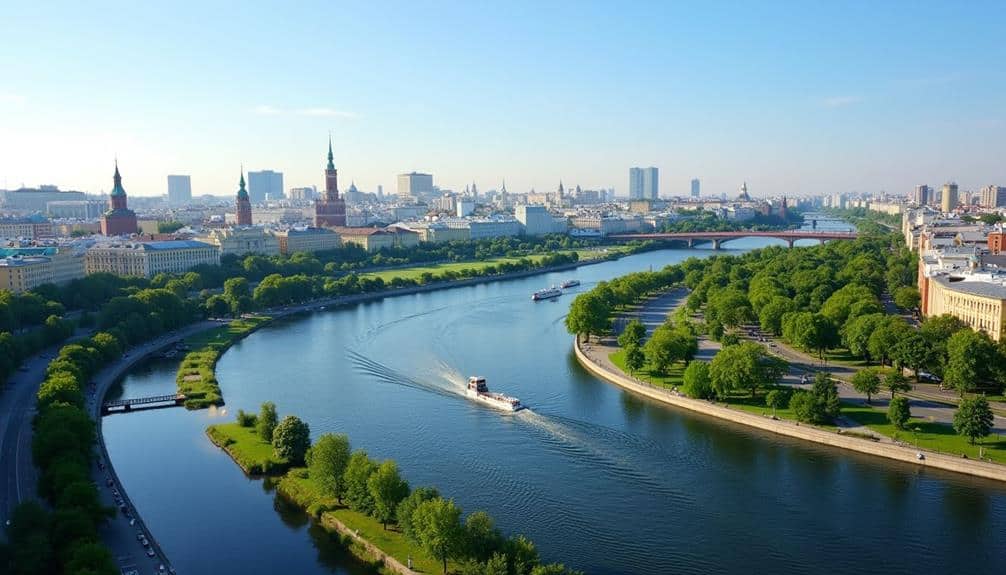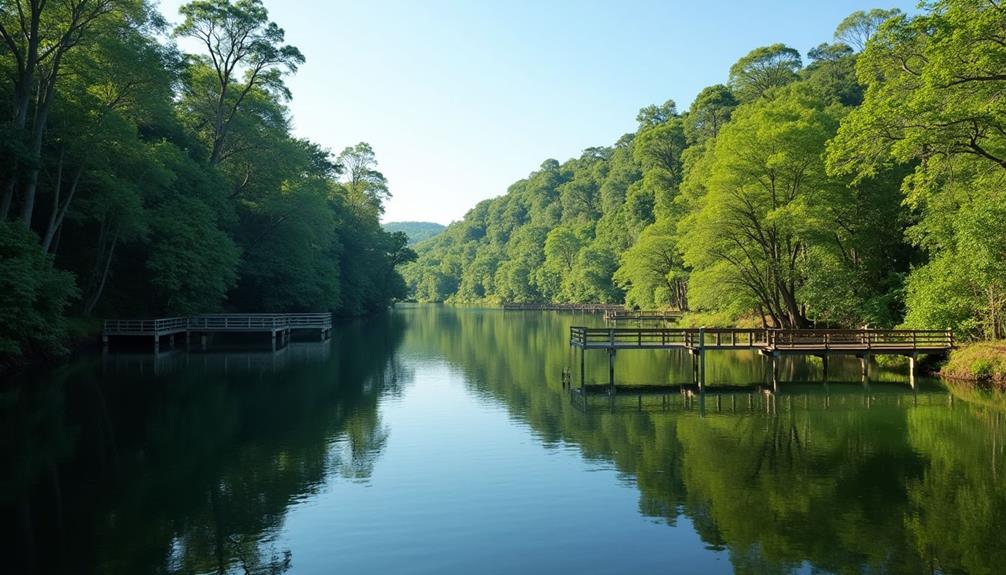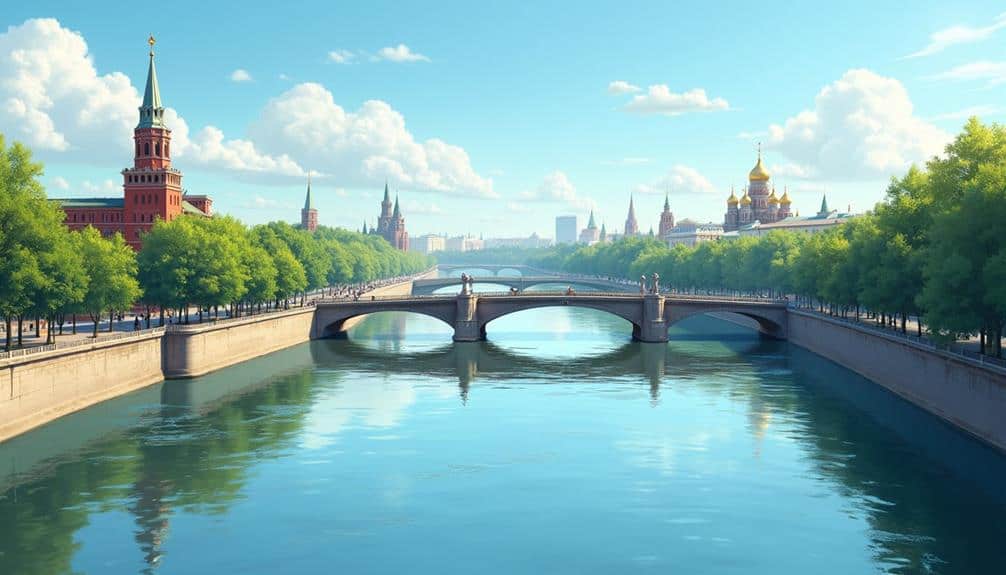The rivers around Moscow, Russia, are more than just waterways; they are essential components of the city’s historical and ecological tapestry. The Moskva River, extending over 503 kilometers, not only facilitates transportation but also frames many of Moscow’s iconic landmarks. Meanwhile, the Yauza and Setun rivers offer recreational spaces and support diverse wildlife, highlighting ongoing conservation efforts. Additionally, the concealed Neglinnaya River, now running beneath the city, underscores Moscow’s complex urban evolution. Each river has a unique story, reflecting both the natural and cultural heritage of this metropolitan area. What historical transformations and ecological initiatives shape these rivers today?
Moskva River

Although often overshadowed by the grandeur of Moscow itself, the Moskva River plays an important role in the city’s geography and history. This river, stretching approximately 503 kilometers, bisects the capital city and serves as both a significant waterway and a scenic focal point.
Historically, the Moskva River has been instrumental in Moscow’s development as a major trade and transportation hub. Its waters facilitated commerce, linking Moscow to other regions and fostering economic growth.
Geographically, the river is a defining feature of the landscape, winding through the heart of the city and offering picturesque views that juxtapose modern skyscrapers with historic landmarks. Notable sites along its banks include the Kremlin, Gorky Park, and the Luzhniki Stadium. These landmarks underscore the river’s centrality to both the cultural and physical layout of Moscow.
The Moskva River also plays an important role in the city’s infrastructure, providing water for industrial and residential use. Additionally, it supports various recreational activities, from river cruises to fishing, enhancing the quality of life for Moscow’s residents and visitors alike.
Understanding the Moskva River is significant for appreciating the full scope of Moscow’s urban and historical fabric.
Yauza River
The Yauza River, a tributary of the Moskva River, holds its own unique significance within the geographical and historical tapestry of Moscow. Stretching approximately 48 kilometers, it meanders through various districts of the city, enriching its urban landscape. The Yauza’s journey begins in the Losiny Ostrov National Park, a notable green space, and flows southward into the Moskva River near the historical center of Moscow.
Throughout history, the Yauza River has played a vital role in the city’s development. In ancient times, it served as a natural boundary and an essential waterway for the settlement of tribes and later, for the burgeoning city of Moscow.
Industrialization in the 18th and 19th centuries saw the Yauza become a hub for factories and workshops, although this led to significant pollution.
In recent years, concerted efforts have been made to restore and preserve the Yauza. Projects aimed at cleaning the river and revitalizing its banks have transformed it into a recreational area for residents and tourists alike.
Parks, walking paths, and cultural sites now line its course, showcasing the Yauza as a rejuvenated artery of Moscow’s urban environment.
Setun River

Setun River, a lesser-known tributary of the Moskva River, offers a serene contrast to Moscow’s bustling urban core. Originating from the village of Salarevo, the Setun meanders through the western districts of Moscow, eventually merging with the Moskva River near the picturesque neighborhood of Fili. Spanning approximately 38 kilometers, this river is an important ecological asset, providing habitats for various flora and fauna.
The Setun River Valley is a designated nature reserve, emphasizing the city’s commitment to preserving its natural landscapes amidst rapid urbanization. The reserve covers an area of around 693 hectares and is home to diverse ecosystems, including mixed forests, wetlands, and meadows.
This protected area not only serves as a sanctuary for wildlife but also offers recreational opportunities for residents and visitors alike, such as hiking, bird watching, and nature walks.
Efforts to maintain the Setun River’s ecological integrity are ongoing, with initiatives aimed at reducing pollution and enhancing water quality. Local authorities and environmental organizations collaborate to implement sustainable practices, ensuring that this tranquil waterway remains a valuable asset for both nature and the community.
Skhodnya River
Beyond the serene landscapes of the Setun River lies another significant tributary of the Moskva River: the Skhodnya River. Stretching approximately 47 kilometers, the Skhodnya River originates near the village of Alabushevo, situated in Moscow Oblast. This river traverses diverse terrains, including urban and rural areas, before merging with the Moskva River within the city limits of Moscow.
The Skhodnya River is not merely a geographical feature; it holds historical and ecological significance. Historically, it has been an essential waterway for local settlements, contributing to the region’s development. The river’s banks once hosted numerous ancient villages, whose remnants can still be found today, providing a glimpse into the past.
Ecologically, the Skhodnya River supports a variety of flora and fauna, making it a fundamental component of the local ecosystem. Efforts have been made to preserve its natural state amidst urbanization, underscoring its importance to biodiversity.
Various recreational activities, including fishing and hiking, are popular along its banks, making it a cherished natural asset for residents and visitors alike.
Neglinnaya River

Flowing beneath the bustling streets of Moscow, the Neglinnaya River represents an intriguing blend of natural history and urban development. Historically, the river played a vital role in the city’s defense and daily life, running openly through central Moscow. However, the increasing urbanization and frequent flooding led to its enclosure in underground tunnels by the early 19th century.
The Neglinnaya spans approximately 7.5 kilometers, originating from the Maryina Roshcha District and merging with the Moskva River near the Kremlin. Its subterranean course is an indication of Moscow’s architectural evolution, reflecting a shift from natural landscapes to engineered urban spaces. Significantly, the river’s flow is controlled by a series of pipes and channels, ensuring it remains hidden beneath the city’s surface.
Despite its concealed nature, the Neglinnaya’s presence is symbolically significant. It underscores the complexities of maintaining natural waterways within a rapidly modernizing metropolis.
In recent years, there have been discussions about partially reopening the river to enhance urban aesthetics and reconnect citizens with their historical waterways. The Neglinnaya River consequently embodies a unique intersection of Moscow’s rich history and its future aspirations.




